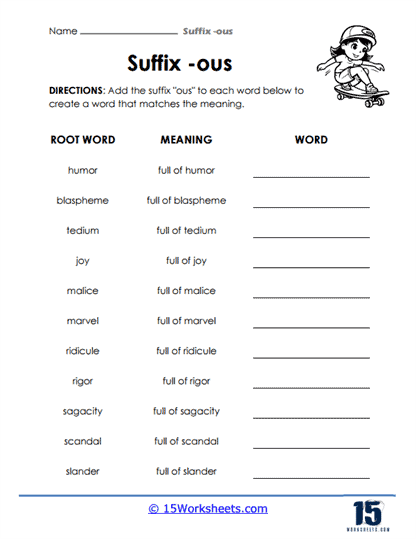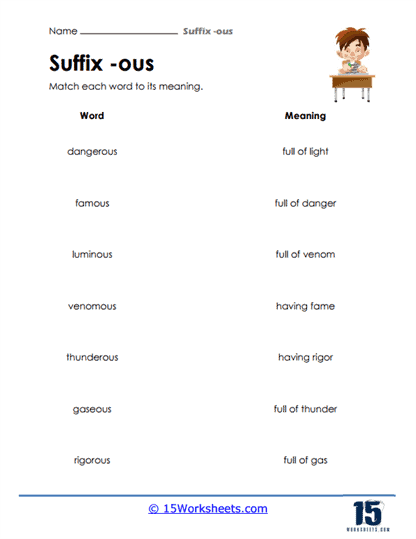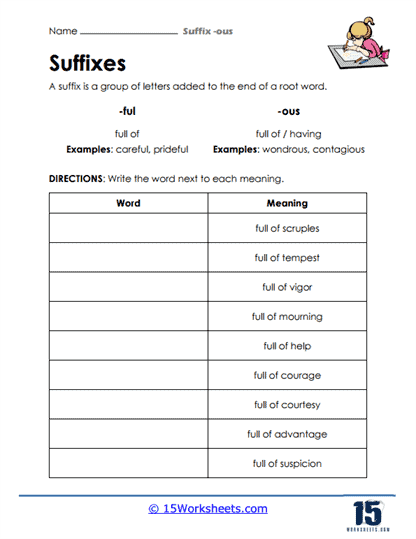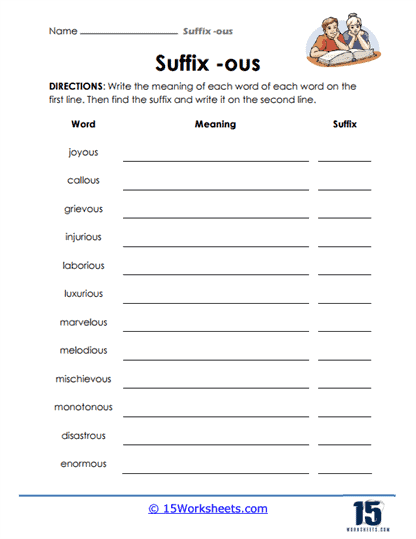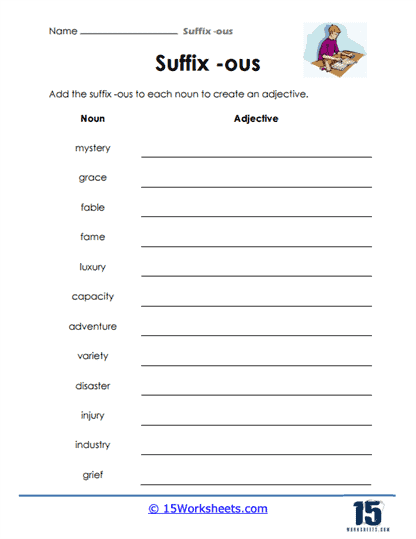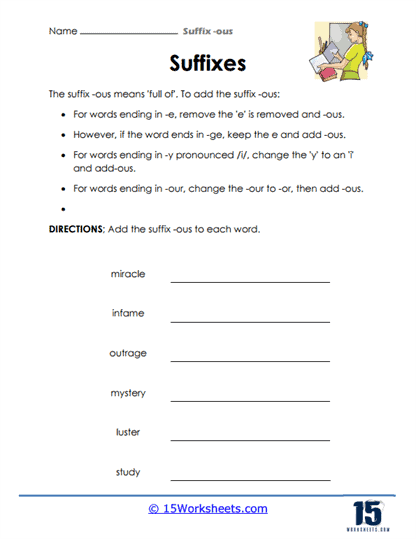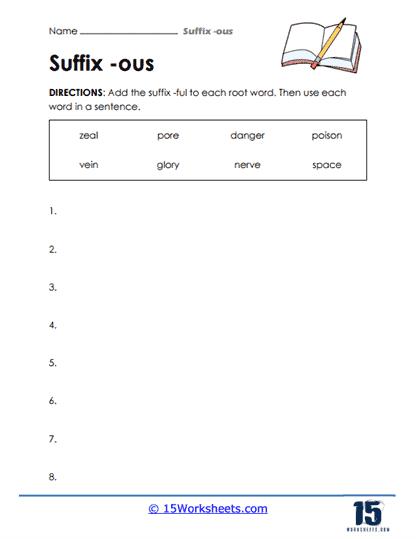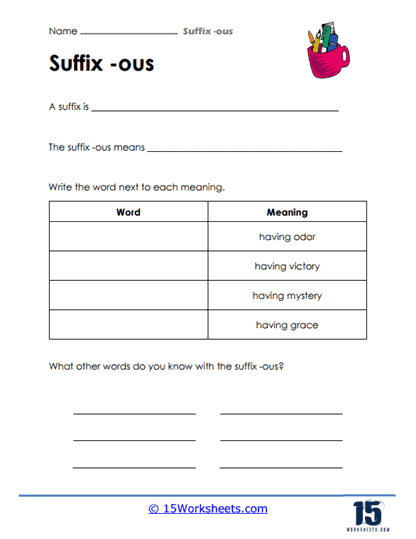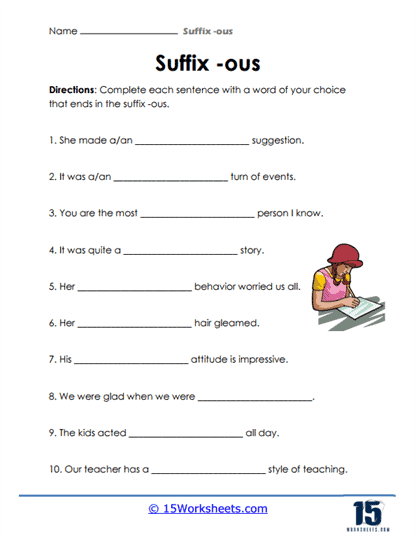Suffix -ous Worksheets
About These 15 Worksheets
Our suffix -ous worksheets will enhance students’ understanding and usage of the suffix “-ous,” which is added to nouns to form adjectives indicating “full of,” “having the qualities of,” or “characterized by.” These worksheets provide a range of exercises aimed at improving students’ grammar and language arts skills by expanding their vocabulary, enhancing their understanding of word formation, and improving their ability to describe nouns more vividly. The suffix “-ous” plays a crucial role in English language composition, making these worksheets an essential component of language learning.
These fun worksheets help you learn new words, make cool sentences, and become a super word wizard! When you do these activities, you’ll get better at words and grammar, plus you’ll become a master storyteller! With these -ous worksheets, you’ll become a language superhero, ready to tackle any word adventure! By integrating suffix -ous worksheets into their study routine, students can significantly improve their language arts skills, setting a strong foundation for advanced language study and effective communication.
Types of Exercises
1. Word Formation – These exercises involve transforming nouns into adjectives by adding the suffix “-ous.” Students learn the rule of adding “-ous” to nouns (e.g., “hazard” becomes “hazardous”) and practice applying this rule to various nouns. This enhances their vocabulary and understanding of how words are formed.
2. Fill-in-the-Blanks – Students complete sentences with the appropriate “-ous” adjective. This exercise helps students understand how these adjectives fit into sentence structures and how they modify nouns, thereby improving their sentence construction skills.
3. Matching Exercises – In these activities, students match nouns with their corresponding “-ous” adjectives (e.g., “danger” with “dangerous”). This reinforces the relationship between nouns and adjectives and enhances vocabulary retention.
4. Sentence Writing – Students use “-ous” adjectives in their own sentences, encouraging them to apply their understanding in a creative context. This not only reinforces their grasp of the “-ous” suffix but also improves their overall writing skills.
5. Identifying “-ous” Adjectives in Texts – Exercises might include passages where students need to identify all the “-ous” adjectives. This improves reading comprehension and analytical skills, as students learn to recognize and interpret the usage of “-ous” adjectives within a broader text.
6. Comparative and Superlative Forms – Students learn to form comparative and superlative adjectives from “-ous” adjectives (e.g., “dangerous,” “more dangerous,” “most dangerous”). Understanding how to express varying degrees of quality enhances their ability to describe and compare.
7. Prefix and Suffix Combination – Some worksheets may introduce students to the idea of adding prefixes to the “-ous” suffix, further expanding their vocabulary and understanding of word formation. For example, adding “in-” to “famous” to form “infamous.”
8. Error Correction – These exercises involve correcting mistakes in the use of “-ous” adjectives within sentences. This sharpens students’ editing skills and reinforces correct usage.
Benefits of These Worksheets
1. Vocabulary Expansion – Regular practice with these worksheets significantly expands students’ vocabulary, enabling them to describe nouns with more precision and variety. A rich vocabulary is essential for effective communication and writing.
2. Improved Writing Skills – Understanding how to use “-ous” adjectives allows students to create more vivid and descriptive sentences. This skill is invaluable for narrative writing, descriptive essays, and any writing task that requires detailed descriptions. A solid grasp of suffixes like “-ous” prepares students for more advanced studies in language arts, including etymology, advanced grammar, and literature analysis.
3. Enhanced Reading Comprehension – Being familiar with “-ous” adjectives helps students better understand and interpret texts. Recognizing these adjectives in reading materials can aid in grasping the nuances of the author’s descriptions.
4. Deepened Understanding of Word Formation – Working with suffix -ous worksheets reinforces knowledge of how words are formed in English, including how suffixes alter the meaning of root words. This foundational knowledge supports learning in all areas of language arts.
5. Improved Editing Skills – Error correction exercises enhance students’ ability to identify and correct their own and others’ writing mistakes. This skill is critical for the writing process and for peer editing activities.
6. Creativity in Language Use – Exercises that require students to use “-ous” adjectives in new sentences or stories foster creativity. Students learn to think creatively about how to describe nouns, enhancing both their writing and critical thinking skills.
7. Confidence in Language Proficiency – Mastery of “-ous” adjectives through consistent practice builds students’ confidence in their language skills. This confidence can lead to increased participation in class and a more positive attitude toward learning.
Using the -ous Suffix
The suffix “-ous” is used to form adjectives from nouns or other adjectives. It typically means “full of” or “having the quality of.” Here are three examples:
“Dangerous” – This word means full of danger. For instance, if something is “dangerous,” it poses a risk or hazard.
“Courageous” – This word means having courage or bravery. If someone is described as “courageous,” it means they have the quality of being brave, facing challenges without fear.
“Mysterious” – This word means full of mystery or something that is hard to understand or explain. For example, a hidden treasure might be described as “mysterious” because it’s difficult to find or comprehend.
Spelling With the Suffix -ous
It usually carries the meaning of “full of” or “having the quality of.” When adding the suffix “-ous” to a word, there are several spelling rules to consider:
Drop the final “e” – When the base word ends with an “e,” it’s usually dropped before adding “-ous.” For example:
Fame —> Famous
Sense —> Sensuous
Value —> Valorous
Keep the final “e” – Sometimes, if the final “e” is preceded by a consonant that’s pronounced, it’s retained before adding “-ous.” For example:
Brave —> Braveous (However, this spelling is uncommon; “Brave” typically becomes “Bravo” when combined with “-ous.”)
Words ending in “-ge” or “-dge” – When the base word ends with “-ge” or “-dge,” the “-ous” suffix is simply added without any alterations. For example:
Courage —> Courageous
Lodge —> Lodgeous (However, this spelling is not standard; typically, “Lodge” does not form an adjective with “-ous.”)
Words ending in “-y” – If the base word ends in “-y,” it’s replaced with “-i” before adding “-ous.” For example:
Fury —> Furious
Envy —> Envious
Words ending in “-ce” or “-cy” – If the base word ends in “-ce” or “-cy,” the “-ous” suffix is added directly. For example:
Grace —> Gracious
Democracy —> Democratic
Words ending in “-ious” – Some words already end in “-ious,” which means they already have the “-ious” suffix. When forming adjectives with “-ous,” the “-ious” suffix is usually replaced with “-ous.” For example:
Ambitious —> Ambitious (The base word “Ambition” is already an adjective ending in “-ious,” so no changes are needed.)
Delicious —> Delicous (The base word “Delicious” ends in “-ious,” so “-ious” is replaced with “-ous.”)
Irregularities – There are some exceptions and irregular spellings when adding “-ous.” For example:
Marvel —> Marvellous (In British English, “Marvelous” is spelled “Marvellous” with an extra “l” before “-ous.”)
Glamour —> Glamorous (The base word “Glamour” has an irregular spelling when forming the adjective “Glamorous.”)





